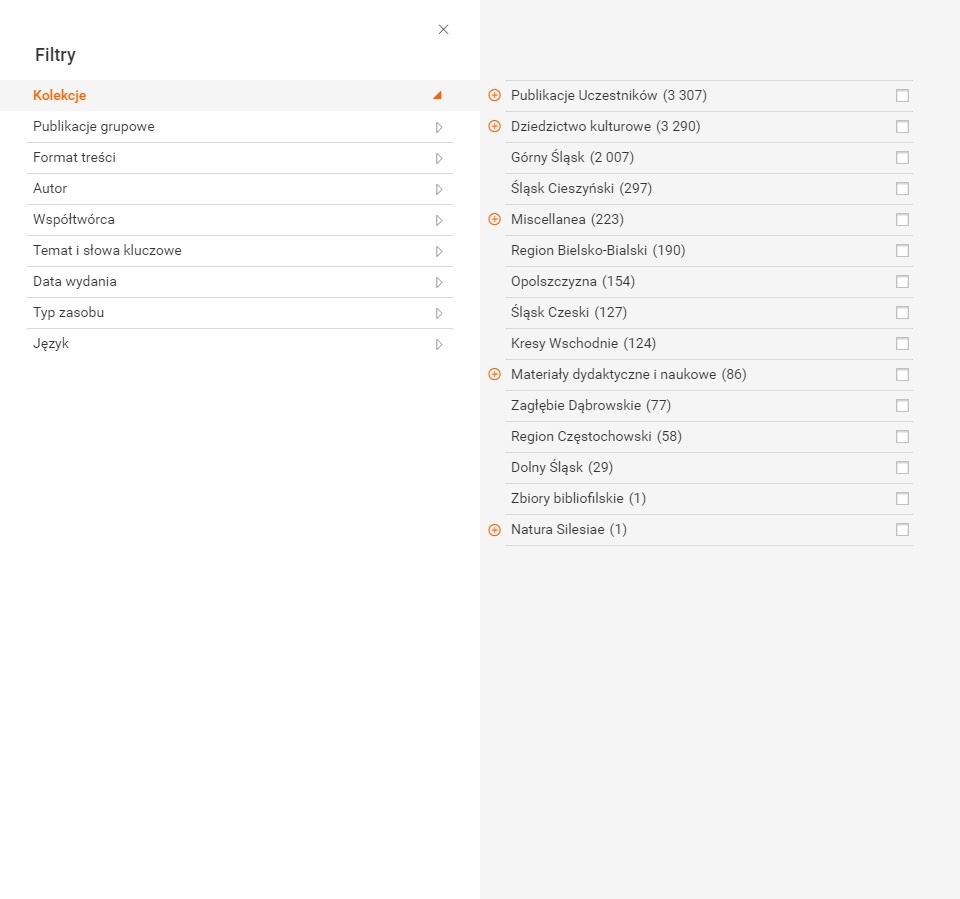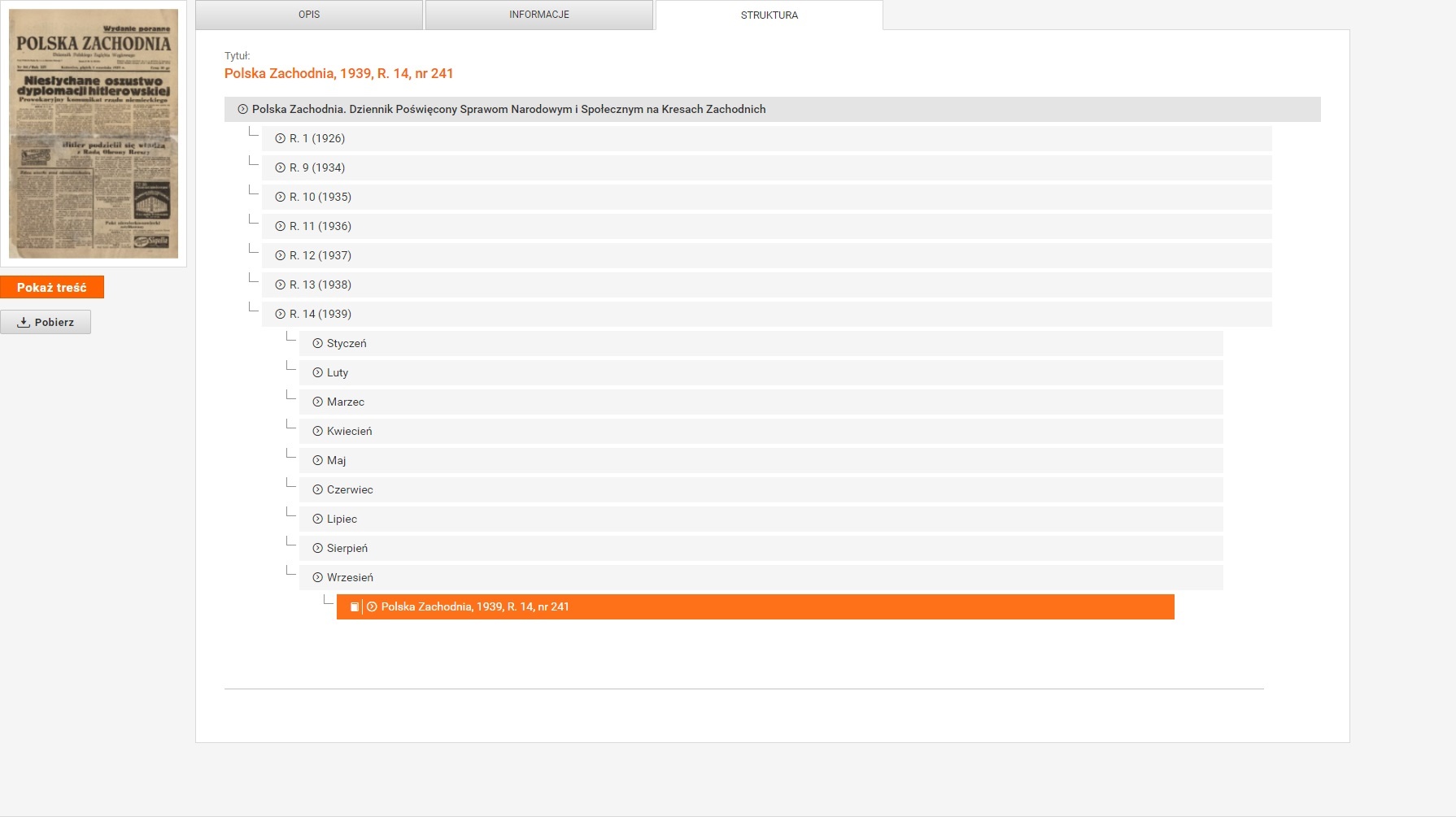...
All search results can be narrowed down with the use of additional filters. The available filters are displayed after every search query, on the search results page. The results can be narrowed down with respect to attributes, collections, group publications, and content formats.
Wyszukiwanie zasobów rozproszonych
Poza wyszukiwaniem lokalnym istnieje możliwość włączenia do biblioteki cyfrowej dLibra wyszukiwania zasobów rozproszonych. Wyszukiwanie rozproszonych zasobów bazuje na protokole OAI-PMH i możliwe jest przy wykorzystaniu usługi wyszukiwania zasobów rozproszonych portalu Federacji Bibliotek Cyfrowych.
Wraz z każdym zapytaniem wyszukiwawczym następuje wysłanie zapytania do serwisu FBC. Najwyżej punktowane wyniki wyświetlane są pod listą wyników z biblioteki lokalnej. Istnieje możliwość wyświetlenia wszystkich wyników w serwisie FBC. Wystarczy kliknąć przycisk "Więcej w FBC". Nastąpi przekierowanie do serwisu FBC, a następnie wyświetlona zostanie lista elementów znalezionych we wszystkich bibliotekach cyfrowych, które wchodzą w skład FBC (aktualna lista znajduje się tutaj). Serwis Federacja Bibliotek Cyfrowych (FBC) jest kolejnym etapem budowy sieci rozproszonych bibliotek cyfrowych i repozytoriów w Polsce. Nazwa serwisu FBC odzwierciedla jego charakter - serwis ten jest zbiorem zaawansowanych usług sieciowych opartych na zasobach cyfrowych dostępnych w polskich bibliotekach cyfrowych i repozytoriach uruchomionych w sieci PIONIER. Zasoby te współtworzone są przez wiele instytucji naukowych i publicznych, takich jak uczelnie wyższe, biblioteki, archiwa, muzea czy ośrodki badawcze. Serwis FBC utrzymywany jest przez Poznańskie Centrum Superkomputerowo-Sieciowe afiliowane przy Instytucie Chemii Bioorganicznej PAN.
Metody przeglądania zasobów biblioteki cyfrowej
Poza wyszukiwaniem obiektów cyfrowych istnieje jeszcze kilka innych sposobów odnajdywania i przeglądania obiektów cyfrowych. Jest to przede wszystkim zestaw kolekcji, który w zorganizowany sposób dzieli obiekty cyfrowe na mniejsze zbiory. Naturalnym podziałem wydaje się być podział tematyczny i tak też wykorzystuje kolekcje większość bibliotek cyfrowych opartych na oprogramowaniu dLibra. Dzięki hierarchicznej organizacji kolekcji podział może rozpoczynać się od bardzo ogólnych zbiorów (np. Materiały dydaktyczne) , które podzielone są na bardziej zawężone podzbiory (np. Matematyka, Fizyka), itd.
Innym sposobem przeglądania obiektów w bibliotece cyfrowej są indeksy utworzone z wszystkich wartości wybranego atrybutu metadanych. To jakie atrybuty będą wykorzystywane do generowania indeksów dostosowywane jest do konkretnych potrzeb instytucji wykorzystującej bibliotekę cyfrową. Przykładowo mogą to być indeksy utworzone na bazie wartości z atrybutów Autor, Tytuł czy Temat i słowa kluczowe.
Obiekty złożone, będące wynikiem zastosowania publikacji grupowej, są przedstawiane w systemie dLibra jako pewna hierarchiczna struktura, po której użytkownik może się swobodnie poruszać. Dzięki temu użytkownik ma dostęp do dowolnej części całego obiektu cyfrowego. Przykładowo jeśli jest to struktura gazety to może ona mieć postać jak przedstawiono na rysunku poniżej.
Stały odnośnik i identyfikator obiektu cyfrowego
Distributed Resource Search
Apart from the local search, there is an option of adding distributed resource search to a dLibra digital library. Distributed resources are searched based on the OAI-PMH protocol, with the use of the distributed resource search service of the Digital Library Federation portal.
For every search query, the query is sent to the DLF service. The best results are displayed under the results list of the local library. There is also an option of displaying all the results in the DLF service, by clicking the “More in DLF” button. The user will be redirected to the DLF service, and a list of the elements found in all DLF digital libraries will be displayed (the current list is published here). The “Digital Library Federation” service is another stage of the construction of the distributed network of digital libraries and repositories in Poland. The name of the DLF service reflects its nature it is a set of advanced network services based on the digital resources available in Polish digital libraries and repositories available in the PIONIER network. Those resources are co-created by many scientific and public institutions, such as higher education institutions, libraries, archives, musea, or research centers. The DLF service is maintained by the Poznań Supercomputing and Networking Center affiliated with the Institute of Bioorganic Chemistry of the Polish Academy of Sciences.
The Methods of Browsing the Resources of a dLibra Digital Library
Apart from searching for digital objects, the user can also find them and browse them in a couple of other ways. One other method is using collections, which are small, organized sets of digital objects. Most digital libraries based on the dLibra system organizes collections on the basis of the natural criterion of theme. The hierarchical structure of collections makes it possible to organize them from general sets to narrower, specific subsets (for example, from “Didactic materials” to “Mathematics” or “Physics”).
Objects can also be browsed with the use of indexes made up of all values of a given metadata attribute. The specific attributes used for generating indexes are selected so as to meet the needs of the institutions which make use of the given digital library. For example, indexes can be created on the basis of the “Author”, “Title”, “Theme”, and “Key words” attributes.
Complex objects (resulting from the use of a group publication) in the dLibra system are presented as a hierarchical structure, which can be easily navigated by the user. Thus, the user can access any part of the whole digital object. For example, if the object is a newspaper, the structure may look as follows.
Digital Object Permanent Link and Identifier
Every publication in the dLibra system has a unique link to a web page which always contains information about that publication. That page consists of the address of the website of the digital library, followed by the /publication/ string and the publication identifier. Such a link may look as followsKażda publikacja w systemie biblioteki cyfrowej dLibra posiada unikalny odnośnik do strony internetowej pod którą zawsze znajdują się informacje na jej temat. Strona ta zbudowana jest z adresu strony internetowej biblioteki cyfrowej po którym następuje ciąg znaków /publication/ oraz identyfikator publikacji. Przykładowo może to być następujący odnośnik: https://sbc.org.pl/publication/257008, który składa się z adresu strony internetowej . This sample link consists of the https://sbc.org.pl website address, ciągu znaków the /publication/ oraz identyfikatora publikacji w tej konkretnej bibliotece cyfrowej 257008.string, and the identifier of the publication in that digital library, 257008.
What is more, every publication in the dLibra system has an automatically generated, unique identifier which is based on the OAI Identifier open standard. Each such identifier consists of the oai prefix, the domain of the repository containing the given object, and a unique identifier in that repository. Those elements should be separated by colons (:). Thus, the identifier of the sample publication would have the following formPonadto każda publikacja w systemie dLibra posiada automatycznie wygenerowany globalny i unikalny identyfikator który jest oparty na otwartym standardzie OAI Identifier. Każdy taki identyfikator składa się z przedrostka oai, domeny repozytorium w którym się dany obiekt znajduje oraz unikalnego identyfikatora w ramach tego repozytorium. Wszystkie te elementy powinny być oddzielone znakiem dwukropka :. Zgodnie z tą zasadą publikacja z poprzedniego przykładu miałaby następujący identyfikator: oai:sbc.org.pl:243088. Szczegóły można znaleźć w samym standardzie That topic is discussed in detail in the OAI Identifier standard.


